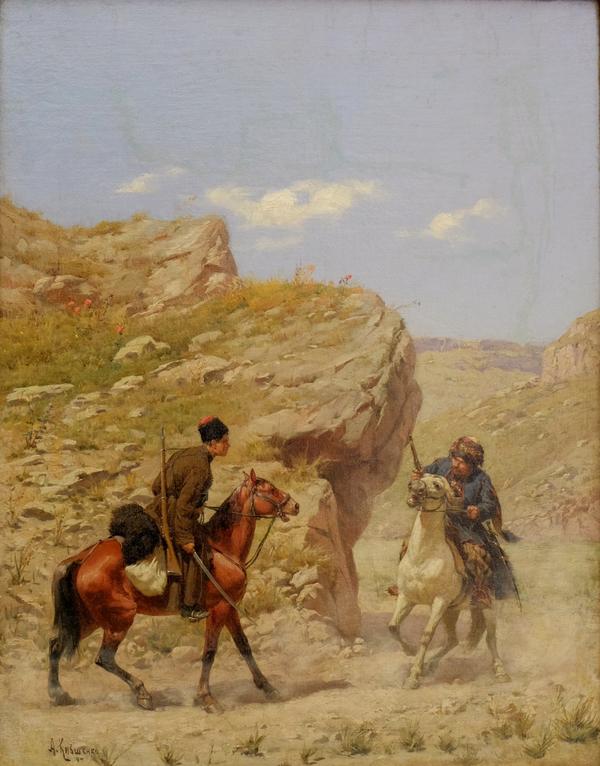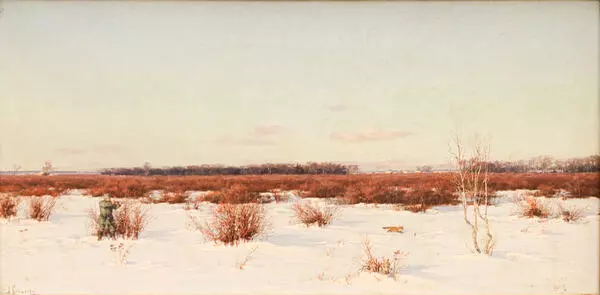Alexey Kivshenko painted the Cossack’s Encounter with a Mountaineer in 1887. He worked in the oil-on-canvas technique. The artist portrayed two horsemen: a Turkish bashi-bazouk and a Cossack. ‘Bashi-bazouk’ was a name applied to fighters from irregular military detachments in the Ottoman Empire. Translated literally from Turkish, the word means a ‘daredevil’ or a ‘reckless person’.
The two horsemen came face to face in the mountains, at the foot of a small rock. The artist depicted the Cossack on a dark horse: he wears a long brown shirt and a black-and-red astrakhan hat, his hand is gripping a saber. A rifle is thrown over his shoulder. The bashi-bazouk on a white horse is heading towards the Cossack. He is dressed in a blue shirt, with a turban on his head and a rifle at the ready. The artist skillfully conveyed the tension between the warriors from an unexpected encounter.
The artist painted this picture while working on a series of battle compositions about the Russo-Turkish war of 1877-1878. In 1883, he received the Imperial commission for paintings to decorate the War Gallery of the Winter Palace. Sketches for each painting were presented for approval by the Grand Dukes and Emperor Alexander III himself. Portrait likeness and landscape authenticity were mandatory requirements.
To study models and landscapes, Alexey Kivshenko first went to South Caucasus in 1884, and then to Turkey. He painstakingly studied the costumes and appearance of local residents. In addition to the paintings commissioned for the Winter Palace, he created a number of other works on the subject of Russo-Turkish military clashes. Art critics and military historians agreed that the artist’s works on the subject were distinguished by natural compositions and devoid of any intentional effect. The artist managed to portray typical images of warriors and authentic locations.
Alexey Kivshenko is generally known for his painting War Council in Fili. It captures one of the most significant moments of the Patriotic War of 1812: the decision to leave Moscow to save the Army. He painted the scene as it was described by Leo Tolstoy in his novel War and Peace. Numerous artists copied the picture, and Kivshenko, too, made several replicas. The painting War Council in Fili has brought worldwide fame to the artist.
The two horsemen came face to face in the mountains, at the foot of a small rock. The artist depicted the Cossack on a dark horse: he wears a long brown shirt and a black-and-red astrakhan hat, his hand is gripping a saber. A rifle is thrown over his shoulder. The bashi-bazouk on a white horse is heading towards the Cossack. He is dressed in a blue shirt, with a turban on his head and a rifle at the ready. The artist skillfully conveyed the tension between the warriors from an unexpected encounter.
The artist painted this picture while working on a series of battle compositions about the Russo-Turkish war of 1877-1878. In 1883, he received the Imperial commission for paintings to decorate the War Gallery of the Winter Palace. Sketches for each painting were presented for approval by the Grand Dukes and Emperor Alexander III himself. Portrait likeness and landscape authenticity were mandatory requirements.
To study models and landscapes, Alexey Kivshenko first went to South Caucasus in 1884, and then to Turkey. He painstakingly studied the costumes and appearance of local residents. In addition to the paintings commissioned for the Winter Palace, he created a number of other works on the subject of Russo-Turkish military clashes. Art critics and military historians agreed that the artist’s works on the subject were distinguished by natural compositions and devoid of any intentional effect. The artist managed to portray typical images of warriors and authentic locations.
Alexey Kivshenko is generally known for his painting War Council in Fili. It captures one of the most significant moments of the Patriotic War of 1812: the decision to leave Moscow to save the Army. He painted the scene as it was described by Leo Tolstoy in his novel War and Peace. Numerous artists copied the picture, and Kivshenko, too, made several replicas. The painting War Council in Fili has brought worldwide fame to the artist.










